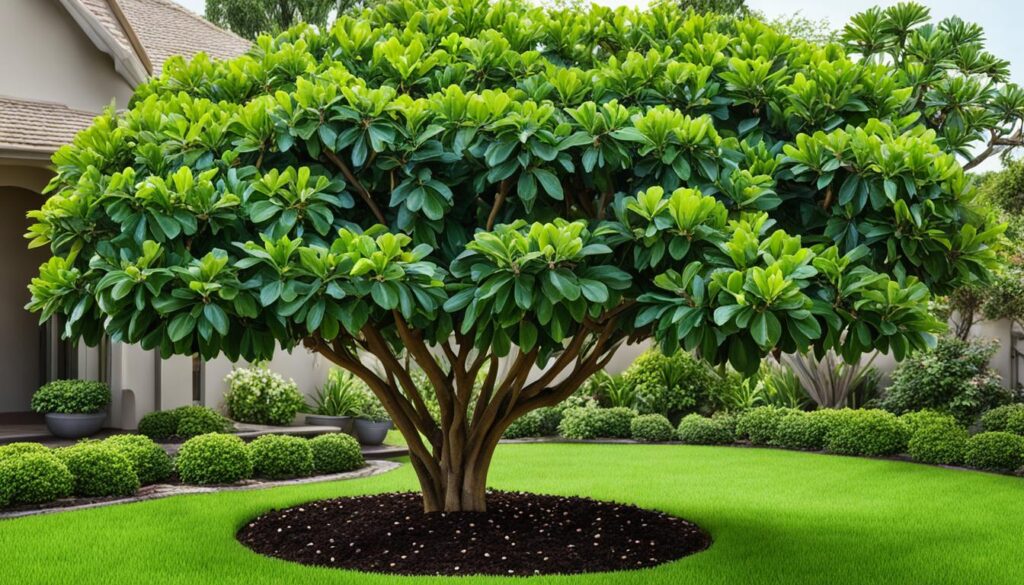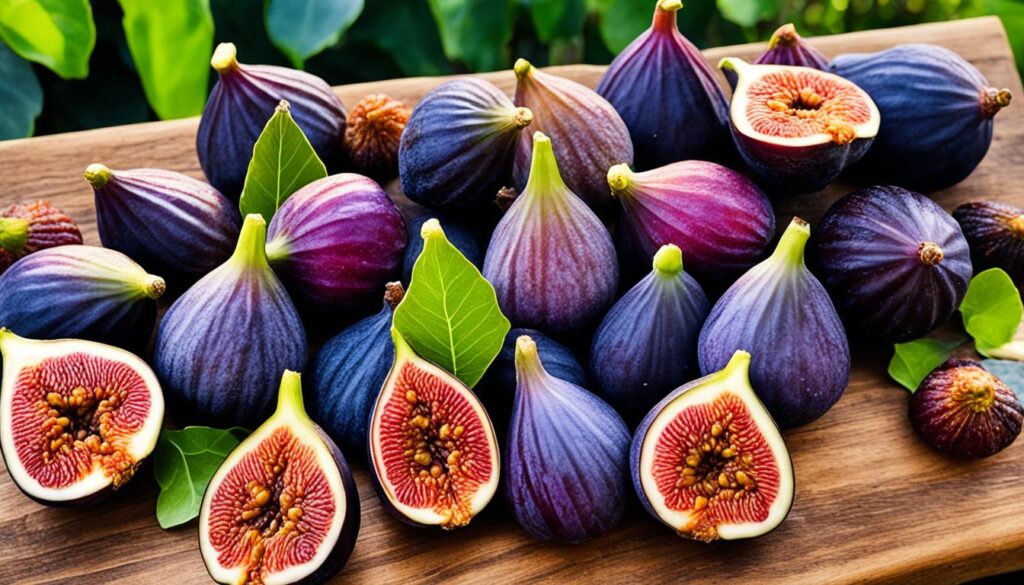
How To Grow Ornamental Figs In The UK – Essential Care Tips and Variety Recommendations
Growing ornamental figs in the UK is an exciting opportunity for plant lovers. These beautiful trees can thrive in the right conditions, providing a stunning addition to any garden or patio. In this guide, we will explore the essential care tips and variety recommendations that will help you successfully grow ornamental figs in the UK. From fig tree care and pruning tips to the best fig varieties for the UK climate, we have got you covered. Let’s dive in!
Key Takeaways
- Choose the right variety for the UK climate, such as ‘Brown Turkey’, ‘White Marseilles’, ‘Brunswick’, or ‘Dalmatie’.
- Provide a warm and sheltered spot for your fig trees, whether planted in the ground or in containers.
- Ensure well-drained soil and consider using vertical paving slabs to restrict the roots when planting in the ground.
- Water your fig trees regularly, especially if grown in containers or with restricted roots.
- Protect your fig trees over winter to prevent frost damage to the fruitlets.
- Feed your fig trees with high potassium fertilizers and liquid tomato fertilizers during the growing season.
- Prune your fig trees annually to remove dead, damaged, or crossing branches and control the tree’s size.
Choosing the Best Fig Varieties for the UK Climate
When it comes to growing ornamental figs in the UK, selecting the right variety is crucial for success. The top choice for our climate is the ‘Brown Turkey’ fig. It is incredibly hardy and thrives in most regions of the country. You can expect plentiful fruit production from this variety when grown outdoors.
‘Brown Turkey’ figs are widely available and have even received the prestigious RHS Award of Garden Merit. This recognition attests to their exceptional quality and suitability for UK gardens. However, there are other fig varieties that also fare well in our climate.
Here are some additional figs to consider:
- ‘White Marseilles’: This variety offers a delightful mix of hardiness and sweetness. Its medium-sized fruits are a favorite among many gardeners.
- ‘Brunswick’: Known for its vigorous growth, ‘Brunswick’ is an excellent choice for those seeking larger-sized figs. The extra effort in caring for this variety will be rewarded with mouthwatering fruit.
- ‘Dalmatie’: If you prefer a fig with exceptional flavor, ‘Dalmatie’ is the one for you. This variety boasts a rich, sweet taste that will elevate your culinary experiences.
To gain further insights and valuable tips on growing different fig varieties, I recommend visiting the RHS gardens. There, you can observe firsthand how experts cultivate these figs and receive expert guidance for your own garden.
Remember, by carefully selecting the best fig variety for your UK garden, you can enjoy a bountiful harvest of delicious and beautiful ornamental figs.

| Fig Variety | Attributes |
|---|---|
| Brown Turkey | Hardy, widely available, RHS Award of Garden Merit |
| White Marseilles | Hardy, medium-sized fruits, sweet flavor |
| Brunswick | Vigorous growth, large-sized fruits |
| Dalmatie | Exceptional flavor, rich and sweet |
Preparing the Ground for Planting Ornamental Figs
Figs are a beautiful addition to any garden, and with the right preparation, you can easily grow ornamental figs in the UK. The key to successful fig tree planting lies in creating the ideal conditions for their growth. In this section, we will explore the soil requirements and planting guide for fig trees, ensuring that you have all the information you need to get started.
Soil Requirements for Fig Trees
Fig trees thrive in warm and sheltered spots with well-drained soil. Before planting, it’s essential to ensure that the soil provides the right conditions for their growth. Figs flourish in slightly acidic to neutral soil with a pH level between 6.0 and 7.5. You can test the pH level of your soil using a simple pH testing kit, which is available at most gardening stores.
Fig Tree Planting Guide
When planting fig trees in the ground, follow these steps:
- Choose a suitable location that offers ample sunlight and protection from strong winds.
- Dig a large hole, big enough to accommodate the root ball of your fig tree.
- Line the sides of the hole with vertical paving slabs to restrict the roots from spreading.
- Leave the base of the hole unlined but fill it with rubble or stones to ensure proper drainage.
- Refill the hole with soil, making sure it’s packed firmly around the root ball.
- Water the newly planted fig tree thoroughly to settle the soil.
If you prefer to grow fig trees in containers, here’s what you need to do:
- Select a large container with good drainage holes.
- Fill the container with free-draining potting compost, such as John Innes No. 3.
- Position the container against a sunny wall to provide extra warmth for the fig tree.
- Place the fig tree in the container, ensuring that the roots are well-covered with soil.
- Water the container-grown fig tree regularly, allowing the excess water to drain away.
By following these soil requirements and planting guidelines, you will give your ornamental figs the best possible start, enabling them to thrive and flourish in your UK garden.
Proper Planting Techniques for Ornamental Fig Trees
Proper planting is crucial for the successful growth of ornamental fig trees. Whether you’re planting in the ground or in containers, there are specific techniques you should follow to ensure your fig trees thrive.
Planting in the Ground
When planting a fig tree in the ground, choose a warm and sheltered spot with well-draining soil. The hole should be deep and wide enough to accommodate the root ball of the tree.
Position the tree against a south- or south-west-facing wall or fence, as this will provide the necessary warmth and protection.
Install wires or trellis to train the branches into a fan shape. This not only enhances the tree’s aesthetic appeal but also promotes optimal fruit production.
Container Planting
If you prefer to grow your fig tree in a container, select a large pot with good drainage. Fill the pot with well-draining potting compost, such as John Innes No. 3.
You have the option of sinking the pot into the ground or keeping it freestanding. Both methods can be effective, but planting the pot in the ground offers additional insulation and stability for the tree.

Regardless of whether you plant your fig tree in the ground or in a container, it’s important to water it regularly during the first growing season. This will help establish the tree’s root system and promote healthy growth.
| Planting Location | Key Considerations |
|---|---|
| In the ground | – Choose a warm, sheltered spot – Position against a south- or south-west-facing wall or fence – Install wires or trellis for training |
| In a container | – Select a large pot with good drainage – Fill with well-draining potting compost – Sink into the ground or keep freestanding |
By following these proper planting techniques, you’ll give your ornamental fig trees the best start and set them up for healthy growth and abundant fruit production.
Essential Care Tips for Ornamental Fig Trees
Proper care is essential for the successful growth of ornamental fig trees. Here are some essential care tips to help you maintain healthy and productive fig trees in your UK garden.
1. Regular watering
One of the most important aspects of fig tree care is regular watering. This is especially crucial for figs grown in containers or with restricted roots. Make sure to water your fig tree consistently, keeping the soil evenly moist throughout the growing season.
2. Winter protection
Protecting your fig tree over winter is crucial to prevent frost damage to the fruitlets. You can wrap the tree’s branches with horticultural fleece or cover it with a frost blanket. Additionally, you can insulate the soil around the base of the tree with a layer of mulch or straw to provide extra protection.
3. Regular re-potting
If you’re growing your fig tree in a container, it’s recommended to re-pot it every couple of years in slightly larger containers. This will provide the tree with ample space for root growth and better nutrient uptake. When re-potting, use a well-draining potting mix suitable for fig trees.
4. Mulching
Mulching around your fig trees with well-rotted manure or garden compost can help retain moisture in the soil. Apply a layer of mulch around the base of the tree, keeping it a few inches away from the trunk. Mulching also helps to suppress weeds and improve soil fertility.
5. Feeding
Figs will benefit from regular feeding with high potassium fertilizers and liquid tomato fertilizers during the growing season. Potassium is important for fruit production and overall tree health. Follow the manufacturer’s instructions for application rates and frequency.
6. Pruning
Annual pruning is necessary to remove dead, damaged, or crossing branches and to control the size of the tree. Prune your fig tree during the dormant season, typically in late winter or early spring. This will promote healthy growth and ensure a well-structured tree.
By following these essential care tips, you can ensure the health and productivity of your ornamental fig trees in the UK. Now let’s explore some common pests and diseases that may affect fig trees in the next section.
Conclusion
Growing ornamental figs in the UK can be a rewarding experience, and with the right care and variety selection, you can enjoy the beauty and abundance of these delightful trees in your own garden. The ‘Brown Turkey’ fig, known for its hardiness, is the perfect choice for outdoor cultivation in most parts of the country. Whether you choose to grow your figs in the ground or in containers, remember that they thrive in warm, sheltered spots with well-drained soil.
To ensure the health and productivity of your fig trees, regular watering, winter protection, and proper feeding are essential. Make sure to water your trees regularly, especially if they are grown in containers or have restricted roots. Protect them from frost damage during winter, and consider re-potting containerized figs every couple of years in slightly larger containers.
Additionally, don’t forget about the importance of pruning. Annual pruning will not only help control the size and structure of your fig tree but also remove dead or damaged branches, promoting healthier growth. By following these care tips and techniques, you can create an optimal environment for your ornamental fig trees and enjoy their bountiful harvest.
FAQ
How do I grow ornamental figs in the UK?
To grow ornamental figs in the UK, choose a suitable variety such as ‘Brown Turkey’. Plant in a warm, sheltered spot with well-drained soil and provide regular watering and winter protection.
What are the best fig varieties for the UK?
The best fig variety for growing in the UK is ‘Brown Turkey’. Other suitable varieties include ‘White Marseilles’, ‘Brunswick’, and ‘Dalmatie’.
What soil requirements do fig trees have?
Fig trees prefer well-drained soil. When planting in the ground, prepare a large hole with vertical slabs to restrict roots and ensure good drainage.
How do I plant ornamental fig trees?
When planting in the ground, dig a hole deep and wide enough for the root ball. Position the tree against a south- or south-west-facing wall and install wires or trellis for training the branches. In containers, use well-draining potting compost and position against a sunny wall.
What care do ornamental fig trees require?
Ornamental fig trees require regular watering, winter protection, and feeding with high potassium fertilizers. Prune annually to remove dead branches and control size.
How do I propagate fig trees?
Fig trees can be propagated through hardwood cuttings or by air layering.
When is the best time to harvest figs?
Figs can be harvested when they are fully ripe and soft to the touch. The first crop forms in late summer and ripens over summer, while the second crop forms in spring and early summer.